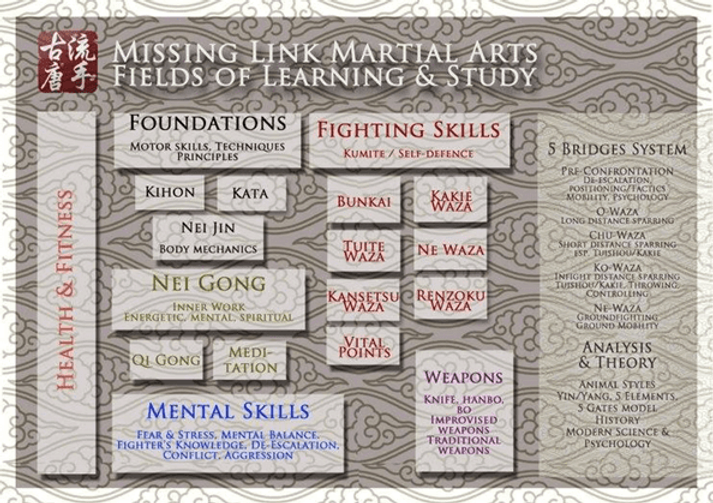The topic isn't exactly new, and we have had a long KarateTalk about it some years ago, but it is a discussion that pops up again and again. What does all the traditional martial arts stuff even mean in our modern world? Shouldn't we drop the whole philosophy and "deep background" of martial arts - especially since it often ends up as cultural appropriation, including costumes and pretentious make belief in the dojo?
When the Shotokan Times approached us asking for our take on the issue, we were very happy to pin down our thoughts and ideas. Of course, the article's approach is very much Shotokan-oriented, but it might still be interesting to see where the Missing Link idea originally started. The Link to the article is here, but the text is also below.
The missing links of Karate have become a research field for a community of innovative and open minded Karateka. We link Karate back to its roots in traditional martial arts from Asia. By doing so we focus on improving Karate and bring back what the art has lost through the development of modern Shotokan and Sports Karate. Therefore, missing links challenges conventional Karate wisdom and changes perceptions.
Questioning Shotokan
Practicing Japanese Karate will always bring up the question: “Which style?” – at least from those in the know. Three decades ago an answer by Hirokazu Kanazawa made the rounds in my Shotokan circles. “Martial arts,” the old master mumbled in reply, and was not willing to discuss this any further.
It impressed me at the time, because back then I had a moment of confusion myself. I had joined the instructor team of the police in the then German capital Bonn. It was a fortunate event to be welcomed in this rather elitist circle of good fighters with all kinds of martial arts backgrounds. I was a complete rookie, while all of them had tested their knowledge in more or less realistic scenarios.
My Shotokan fell short. What I had learned was too static, too focused on the long distance, and very much tuned into the rules of competition.
Shotokan did not meet the reality of fighting nor philosophical depth of Asia
Not an unusual story – I have met plenty of others with similar experiences, not only from Shotokan Karate. If you listen to Geoff Thompson, British author and martial artist, he describes the same learning journey. Self defense, realistic conflict, and violence prevention always question what we have learned in the dojo.
This was not the first time I second-guessed my Karate. When I started my training in Shotokan, coming from Judo and Tai Chi, I became disappointed at first. I found a sports system featuring tournament rules instead of the deep secrets I had expected. It was all sweat, mostly on my own, walking up and down a gym, hitting thin air. No Far East philosophy, nothing of the cool mystic background I imagined.
The Two Missing Links
Two missing links gave our research community its name: The actual combat content, and the deep knowledge, the Asian ways of thinking that challenge the Western mind.
The Bleeding Edge of Modern Society
This brings us straight to the core of martial arts: The connection of body and mind. What sounds like an advertising soundbite to the ears of experienced Karateka is a bleeding edge of modern society. In our book Missing Links of Martial Arts, we chose the term “debodification” to describe what is happening to humans today: An increasingly sedentary lifestyle dominated by screentime and virtual experiences. Fitness and wellness have the character of mere duties that have to be fulfilled. Looking good, being healthy, showing positive attitude is a mere part of a “personality package,” not a source of learning and personal growth.
This betrays modern people of genuine experiences that can only be made using the body. Some people aim to fill this gap in personal growth by attending Asian health systems like Yoga, Qi Gong, or meditation. Traditional martial arts offer the same philosophy in motion, and they bring even more to the table: Conflict, fear, stress, social skills, and communication.
The Depth of the Traditional Asian Styles
Modern fitness and self defense based systems offer much less depth. While mixed martial arts competition is a fantastic sport and often underrated by Karateka (also because of the testosterone-laden scenarios of competition in the octagon), it does not regard the deeper content of traditional martial arts. Do not underestimate MMA athletes, though. Many of them come from traditional systems and practice much more than what they need in tournaments. Grappling styles like Brazilian Jujitsu offer physical and mental training, as well as holistic knowledge. Nothing, however, beats the traditional Asian styles.
The roots of our Karate go back to older arts from Okinawa and China, a fact that has not only been forgotten by many who think Karate is part of the traditional Japanese Budo curriculum. But it has been hidden by Japanese masters who went out of their way to rebrand Karate from “Chinese Hand” to “Empty Hand,” simply by changing the Kanji of the name.
In our Missing Link Community, we use the original character: Ko Ryu Kara Te – old style Chinese hand. The look backwards to China and old Kung Fu styles is as important to us as the focus on modern application and usability. We avoid chitter chatter about “the street” and what is useful. We care about what we can learn for everyday scenarios that actually happen in modern life.
Chinese Martial Arts as Compendium for Modern Karate
What did we find in the Chinese arts?
Flow
First and foremost: Flow. Static stances, powerful hard movements – both can be more obstacle than help for good martial arts:
- Nothing is static in a fight.
- A stance is just a short moment in the context of a bigger event.
- The entire movement is much more important than the end position of a step.
- Low stances only make sense in the context of weight shift and power development; they have no value on their own.
- Every technique, any combination, needs to work in a flow, and with a partner.
Nothing is more important than constant partner training. It is essential to develop mental flexibility and the ability to adapt to ever changing circumstances.
Structure
Another important issue is structure:
- Posture,
- stability,
- full body movements and
- the understanding of principles
This approach is superior to learning single techniques and executing them with maximum strength.
Connect Body and Mind
Understanding – and feeling – the body and its movement makes for good martial arts. Discovering the capabilities of the own body and transferring it into work with a partner is surprisingly often neglected in Karate dojos, in favor of endless repetitions of techniques that make no sense without bunkai – the deep analysis of their meaning and usage. The external form of techniques, especially at the END of the movement, is getting much more attention than the application and the internal development of strength and power.
These holistic physical experiences create the connection of body and mind mentioned above. The body is the most important gate for emotional learning, and thus for the development of social skills, communication, conflict competence, coping with stress and fear, or in short: A life lived to the fullest.
No other physical training connects body and mind like the traditional martial arts do. The individual and their interaction with others is the main concern of our practice.
The fallacy of tribal structures
So what is in a style? Why is the question, “What kind of martial arts do you practice” so important?
The martial arts community as a whole has a very tribal structure. That arose surely from the way of teaching it in family structures in the past and then became a matter of national pride. Many Westerners are trying to be more authentic than their Asian teachers – so much that it borders cultural appropriation.
Hierarchy and patriarchal structures in many associations are another issue. Not questioning the “master,” worshiping belt colors and double-digit dan degrees leads to an inability to challenge opinions, ask questions or be innovative.
Last but not least, styles give a level of security. To define what you are doing (and what you are not doing) gives control over your own training and a chance to measure your ability. “I have mastered this move, this kata, the rules of Shobu Ippon – I am a master now, my education is finished. I know where I am standing.” The comfort of narrow boundaries is enormous.
New ideas can be challenging
We experience this in our dojos. Our ideas attract high ranked, experienced Karateka. But far too often they are also put off. “I have learned more in one of your lessons than in the last five years of training in my home dojo,” an experienced competition fighter told me. She was was talented, intelligent and fast. “I don’t like it,” she went on. “I will go back to my old dojo.”
Boom! Removing limits drops students into a void and leaves them confused. Our response is a sophisticated Kyu curriculum and a proper syllabus, giving beginners a scaffolding for their learning experience. That is not the answer for advanced practitioners, though. Training with Missing Link is uncomfortable, challenging and needs engagement. That is what we face every day ourselves.
A Research Community for Karate
We see Missing Link as a research community. Yes, we build up new martial artists. But we also build up the knowledge of the community, and take on board the ideas and new impulses from experienced teachers joining us. Our ranking system is free of Dan degrees. The Okuden and Kaiden Master Levels that we use instead are not earned in a grading, but by delivering a thesis, a new idea, an own concept to the community.
A diverse community
This has brought an interesting mix of people to the Missing Link Community that started as a Shotokan-based venture. Soon members of our old ShoShin Projekt – a group of martial artists from different styles working together – joined the group. By now, our dojos in Germany, Scotland, Malta, England, Denmark and Finland combine a colorful bunch of Karateka with a wide knowledge and the hunger to learn and discover more. The topics we care about grew beyond the narrow definitions of a style:
Innovative and open minded tradition
What connects all teachers in Missing Link is the idea of a foundation curriculum, described in our book Missing Links of Martial Arts, and the general approach to teaching and learning, also detailed in the very same book. We feel that we have left the limits for personal development behind us in the past. But it also built a strong framework in which Karateka can feel at home if they don’t want to be restrained by an association that cares more for competition sport and purity of styles. Tradition, from our point of view, has to be innovative and open minded.
The Shotokan style is still a basis for many of our members. It has enormous values as a clean, straightforward gate into the complex world of martial arts. We call it the “Japanese garden of martial arts,” pretty and with intense focus. From this garden we want to head for the jungle, though.




